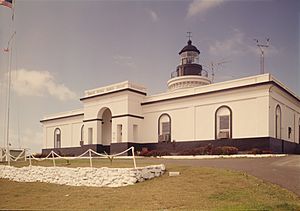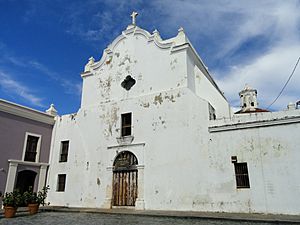Beatriz del Cueto facts for kids
Beatriz Del Cueto López-Hidalgo, born in Cuba in 1952, is a special kind of architect. She focuses on conservation and architectural preservation. This means she helps to save and restore old buildings. She has lived in Puerto Rico since 1960. Beatriz del Cueto has received many important awards, like being a Fellow of the American Academy in Rome and winning the Henry Klumb Award in 2012.
Quick facts for kids
Beatriz Del Cueto López-Hidalgo
|
|
|---|---|
| Born |
Beatriz del Cueto López-Hidalgo
1952 (age 72–73) Havana, Cuba
|
| Nationality | Cuban-American |
| Other names | Beatriz del Cueto de Pantel |
| Occupation | preservation architect |
| Years active | 1984 – present |
| Known for | restoration of the Iglesia San José |
| Spouse(s) | Agamemnon Pantel |
Contents
About Beatriz Del Cueto
Beatriz del Cueto López-Hidalgo was born in Havana, Cuba, in 1952. Her family moved to Puerto Rico in 1960. She went to the University of Florida to study architecture. She finished her first degree in 1974.
She then studied more at the Preservation Institute of Nantucket. There, she learned about saving old buildings and historical places. In 1976, she earned a Master's degree in Architecture. This degree focused on preservation.
After her studies, she moved back to Puerto Rico. In 1977, she started working for a famous architect named Henry Klumb. After three years, she began working for the State Historic Preservation Office. This office helps protect important historical sites.
Her Work and Teaching
In 1984, Beatriz del Cueto moved to Rome, Italy. She studied with her husband, Agamemnon Pantel. They learned at a special center for studying how to preserve cultural heritage.
From 1984 to 1986, she worked at the College of Architects of Puerto Rico. In 1986, she started her own business. By 1990, she joined her husband to form Pantel del Cueto & Associates. Their company helps people understand old buildings in the Caribbean.
Their projects to save old buildings are well-known. Besides her company in San Juan, she also started a special lab. This lab is at the Polytechnic University of Puerto Rico. There, she teaches students about saving old buildings. She also teaches how to study the materials used to build them.
In 2011, Beatriz del Cueto won the Rome Prize. This award allowed her to research how concrete was used in old buildings. In 2012, she received the Henry Klumb Award. This is Puerto Rico's top architecture prize. She won it for her teaching and for helping save many historic places on the island.
Amazing Preservation Projects
Beatriz del Cueto has worked on many important projects. She helps bring old buildings back to life. Here are some of her most famous works.
Restoring Lighthouses
One big project was restoring 15 lighthouses in Puerto Rico. These lighthouses were very old and falling apart. Her main goal was to save these buildings. First, she studied the history of each lighthouse.
The lighthouses were built between 1880 and 1882. The Spanish Government built them. They used a style of building with masonry, which means using stone or brick. The walls were made of limestone, sand, and lime. They also had mud bricks.
The roofs were flat and made of wood. The top layer of the roof helped collect rainwater. This water went into a cistern for drinking. After the Spanish-American War in 1898, the lighthouses belonged to the United States. They were used until the 1970s. When the restoration started in 1988, they had been empty for about ten years.
Cape San Juan Light
Beatriz del Cueto's most important lighthouse project was the Cape San Juan Light. This lighthouse is in Fajardo. It is the oldest lighthouse in Puerto Rico. The building has one story and is made of stone. It is in a neoclassical style.
A round stone tower is attached to the keeper's house. The light from the tower could originally be seen for 19 miles. After the restoration, it could be seen for 25 miles. The project also fixed the system that collected rainwater. Now, the water is used for the bathrooms.
The lighthouse is in a nature reserve. After it was fixed, it opened for tours. Part of the keeper's house became a marine laboratory. This lab is for the Universidad de Puerto Rico en Humacao. This meant the buildings had to meet modern safety rules. The lighthouse restoration was finished in 1991.
Saving Iglesia San José
The San José Church (Iglesia de San José) is a very old building. It was built in the 1500s in Old San Juan, Puerto Rico. The church had to close in 2002 because it was becoming unstable. In 2003, Beatriz del Cueto's company started to check the damage.
The first step was to stop the building from getting worse. To help with this, the church was put on the World Monuments Watch List in 2004. This list highlights important sites that need help.
Using New Technology
During the checking phase, del Cueto used a special tool. It was called ground-penetrating radar. This was one of the first times this technology was used in the Caribbean. This tool lets experts see what is under the ground without digging. It helps them understand the building's hidden parts. This way, they don't cause more damage.
The analysis took four years. It showed many changes and repairs made to the church over its 478 years. Once the checking was done, the actual repairs began. The conservation and repairs were completed in 2012.
Other Important Works
- Faro Las Cabezas de San Juan, Fajardo
- Headquarters of the College of Architects Puerto Rico, Santurce
- Mansion housing the Conservation Trust of Puerto Rico, Old San Juan
- Old Girls Asylum, Miramar
- Conservatory of Music of Puerto Rico, Miramar
- Old Provincial Secondary School, known as the Department of Health, Santurce
- Hacienda La Esperanza, Manatí
- Church of San José, Old San Juan
See also
 In Spanish: Beatriz del Cueto López para niños
In Spanish: Beatriz del Cueto López para niños



